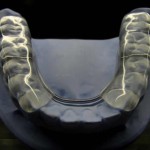
Randomized controlled trials have previously addressed the efficacy of mandibular advancement devices (MADs) in the treatment of obstructive sleep apnoea (OSA). The control used in these studies is usually nasal continuous positive airway pressure (nCPAP). It is frequently found to be superior to MAD therapy. In most of these studies nCPAP was titrated objectively but not MAD. To enable an unbiased comparison between both treatment modalities, the MAD should be titrated objectively as well.
The aim of the present study was to compare the treatment effects of a titrated MAD with those of nCPAP and an intra-oral placebo device.
Sixty-four mild/moderate patients with obstructive sleep apnoea (aged 52.0 +/- 9.6 years) were randomly assigned to three parallel groups: MAD, nCPAP and placebo device. Two polysomnographic recordings were obtained for all patients: one before treatment and one after approximately 6 months of treatment.
They found:-
- A significant change in the apnoea-hypopnoea index (Delta AHI) between the three therapy groups (ANCOVA; p = 0.000).
- No differences in the DeltaAHI were found between the MAD and nCPAP therapy (p = 0.092),
- AHI changes in the MAD and nCPAP therapy groups were significantly larger than those in the placebo group (p = 0.000 and 0.002, respectively).
They concluded:-
There is no clinically relevant difference between MAD and nCPAP in the treatment of mild/moderate OSA when both treatment modalities are titrated objectively.
Aarab G, Lobbezoo F, Hamburger HL, Naeije M. Oral appliance therapy versus nasal continuous positive airway pressure in obstructive sleep apnea: a randomized, placebo-controlled trial. Respiration. 2011;81(5):411-9. Epub 2010 Oct 20. PubMed PMID: 20962502.
